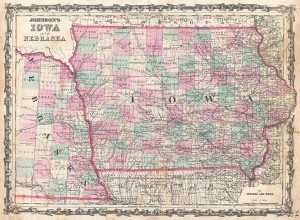 Today Union General Ulysses S. Grant and Confederate General Robert E. Lee clash yet again as Union forces continue maneuvering in an effort to outflank Lee’s Army of Northern Virginia and advance upon Richmond. Today’s action takes places less than 20 miles from the Confederate capital in the Battle of Totopotomoy Creek, also known as the Battle of Bethesda Church.
Today Union General Ulysses S. Grant and Confederate General Robert E. Lee clash yet again as Union forces continue maneuvering in an effort to outflank Lee’s Army of Northern Virginia and advance upon Richmond. Today’s action takes places less than 20 miles from the Confederate capital in the Battle of Totopotomoy Creek, also known as the Battle of Bethesda Church.
Part of the action takes place in the vicinity of the Bethesda meeting house, established in 1830 and currently utilized by two congregations: Baptist and Disciples of Christ.
The Confederates, having established defensive positions early, manage to largely hold off Union forces in the three day battle, or more properly, the three days of small clashes or collisions. Yet Lee pays a steep price, suffering more than twice the casualties (nearly 1600) than does the Union. The Bethesda Church is damaged, although the building remains standing until it burns in 1868.
Knowing that Confederate casualties are rapidly mounting through the course of battles that have thus far comprised the Atlanta Campaign, Grant on the 31st determines that he cannot achieve clear victory. So yet again, the Union general begins pulling his troops from the battlefield and marching toward a better location. The troop movement begins under the cover of darkness. The destination lies southward, at Cold Mountain.
Normalcy is hard to come by for Baptist churches in the vicinity of battles, as testified by the Bethesda Church. One church scarred by battle, however, manages better than most. Cartersville, Georgia’s Racoon Creek Baptist Church (formed in 1837) property mere days ago had been temporarily occupied by Union General William T. Sherman‘s army. For three days Sherman’s troops had camped out on the property. Yet a survey of the church grounds brings joy to congregational members: unlike so many other churches utilized by soldiers during the war, the Yankees did not damage the property, and all is well.
Not only does the Raccoon Creek Baptist Church survive Sherman’s army intact, but throughout the war the congregation never misses more than two church conferences in succession, a remarkable achievement that eludes many Baptist churches of the South whose property is never touched by the war.
While armies clash southward this month, Baptist life in the North carries on, often with a sense of normalcy that belies the pervasiveness of the war.
In the meeting house of the First Baptist Church of Hightstown, New Jersey, the Hightstown Female Seminary is established. In August the school is changed to coeducational and renamed the New Jersey Classical Institute, and then in 1872 is renamed again as the Peddie School (named after a major donor).
Meanwhile, in Council Bluffs, Pottawattamie County, Iowa the Baptist Council Bluffs Church (Primitive Baptist), formed in 1856, moves into the congregation’s first meeting house.
Sources: Battle of Totopotomy Creek (link) and (link); Battle of Bethesda Church (link); Peddie School (link); “Primitive Baptist Church History: Council Bluffs, Pottawattamie County, Iowa” (link); History, Raccoon Creek Baptist Church (link)


